Media Portfolio: Analyzing Racism's Impact on Indigenous Australians
VerifiedAdded on 2020/04/07
|18
|4528
|99
Report
AI Summary
This media portfolio examines the impact of racism on Indigenous Australians, focusing on the critical issues of suicide and mental illness. The report analyzes four recent media items, including news articles from SBS and NITV, and inquest reports, which highlight the historical and ongoing health disadvantages experienced by Indigenous communities. The analysis explores how racism contributes to psychological distress, mental illnesses, and increased suicide rates among Indigenous Australians. The assignment connects the media items to course topics, discusses their contributions to the ongoing debate, and offers personal reflections on the issues. The portfolio emphasizes the need for government support, holistic approaches, and community-level interventions to address the complex challenges faced by Indigenous Australians. The report also considers the role of social determinants of health, such as unemployment, lack of land, and poor access to care services, in exacerbating the health disparities experienced by Indigenous communities.
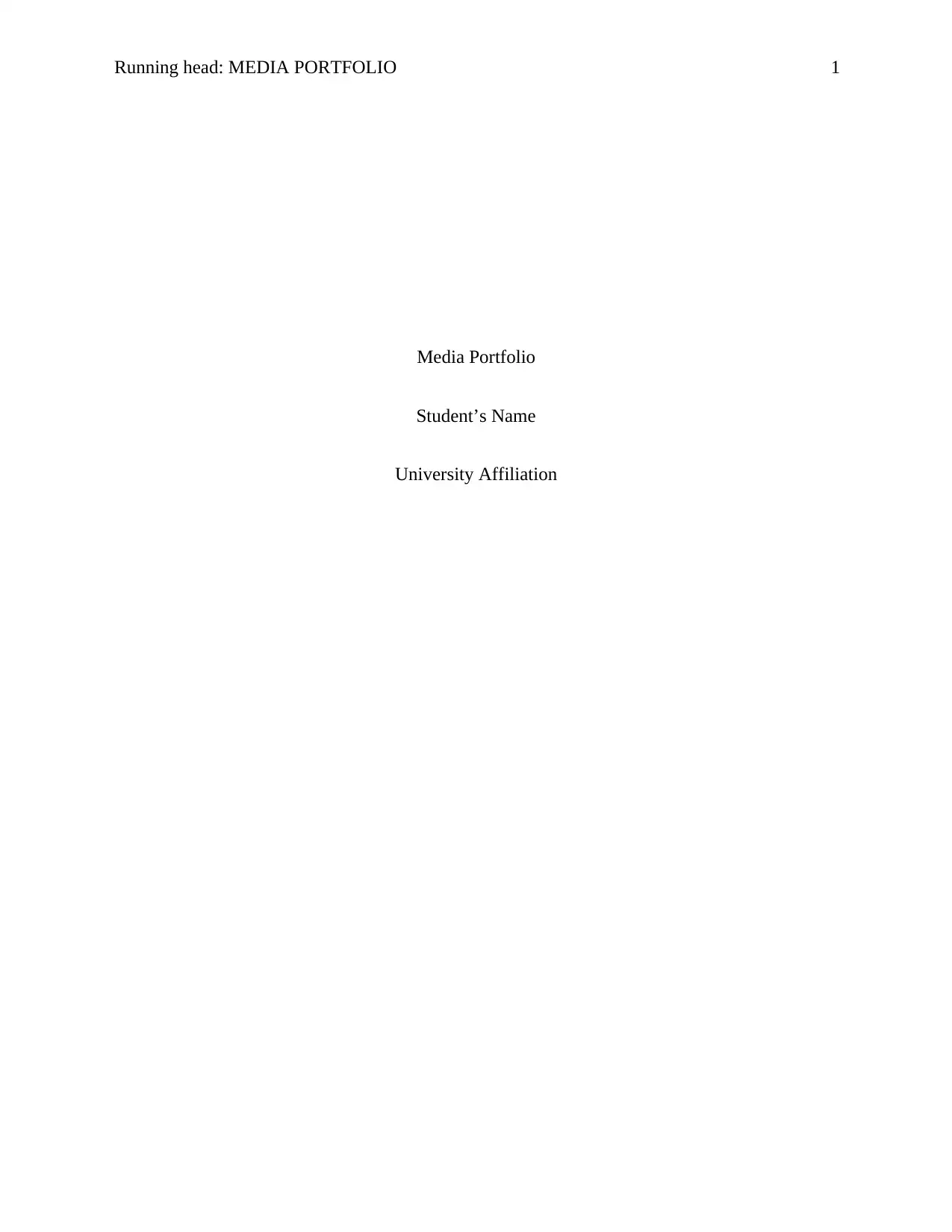
Running head: MEDIA PORTFOLIO 1
Media Portfolio
Student’s Name
University Affiliation
Media Portfolio
Student’s Name
University Affiliation
Paraphrase This Document
Need a fresh take? Get an instant paraphrase of this document with our AI Paraphraser
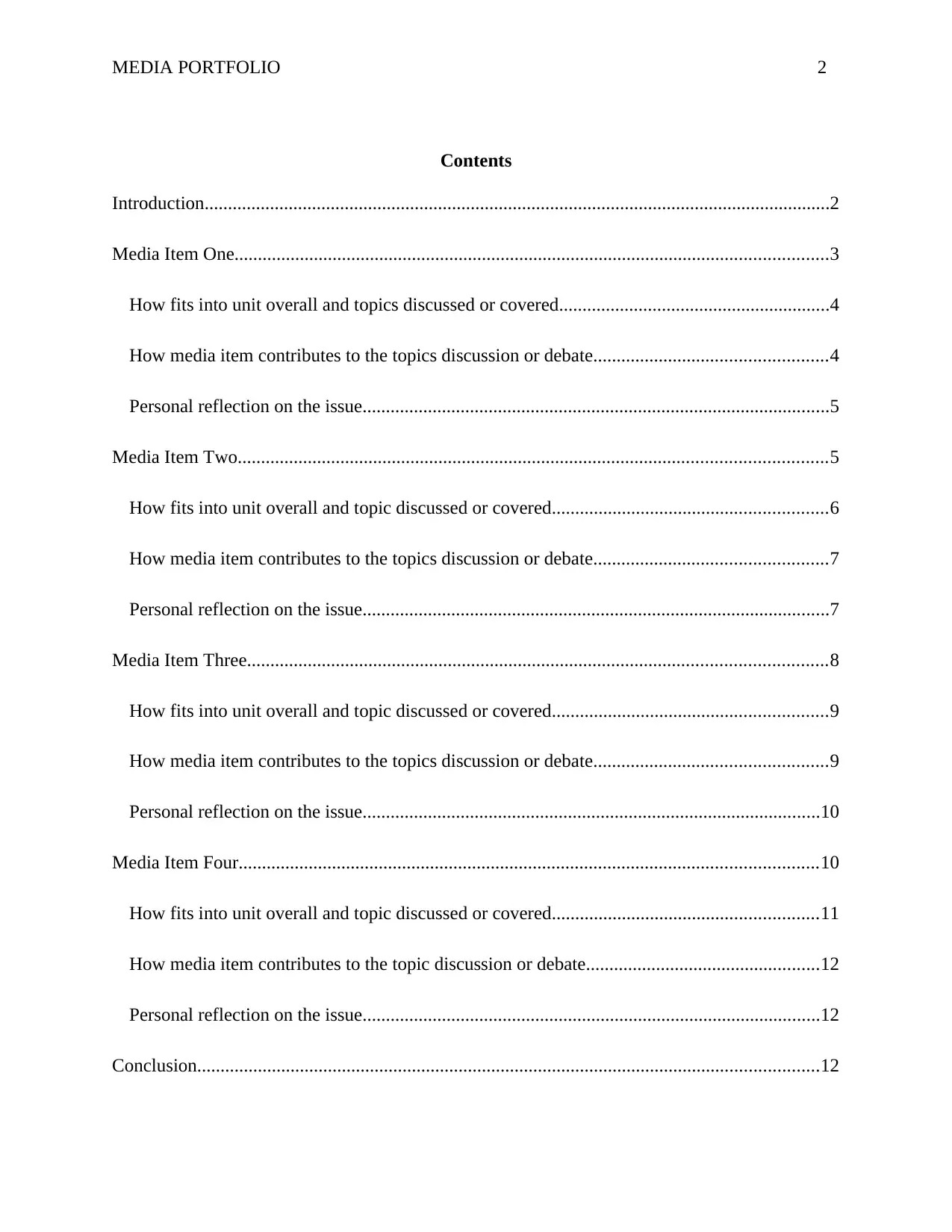
MEDIA PORTFOLIO 2
Contents
Introduction......................................................................................................................................2
Media Item One...............................................................................................................................3
How fits into unit overall and topics discussed or covered..........................................................4
How media item contributes to the topics discussion or debate..................................................4
Personal reflection on the issue....................................................................................................5
Media Item Two..............................................................................................................................5
How fits into unit overall and topic discussed or covered...........................................................6
How media item contributes to the topics discussion or debate..................................................7
Personal reflection on the issue....................................................................................................7
Media Item Three............................................................................................................................8
How fits into unit overall and topic discussed or covered...........................................................9
How media item contributes to the topics discussion or debate..................................................9
Personal reflection on the issue..................................................................................................10
Media Item Four............................................................................................................................10
How fits into unit overall and topic discussed or covered.........................................................11
How media item contributes to the topic discussion or debate..................................................12
Personal reflection on the issue..................................................................................................12
Conclusion.....................................................................................................................................12
Contents
Introduction......................................................................................................................................2
Media Item One...............................................................................................................................3
How fits into unit overall and topics discussed or covered..........................................................4
How media item contributes to the topics discussion or debate..................................................4
Personal reflection on the issue....................................................................................................5
Media Item Two..............................................................................................................................5
How fits into unit overall and topic discussed or covered...........................................................6
How media item contributes to the topics discussion or debate..................................................7
Personal reflection on the issue....................................................................................................7
Media Item Three............................................................................................................................8
How fits into unit overall and topic discussed or covered...........................................................9
How media item contributes to the topics discussion or debate..................................................9
Personal reflection on the issue..................................................................................................10
Media Item Four............................................................................................................................10
How fits into unit overall and topic discussed or covered.........................................................11
How media item contributes to the topic discussion or debate..................................................12
Personal reflection on the issue..................................................................................................12
Conclusion.....................................................................................................................................12
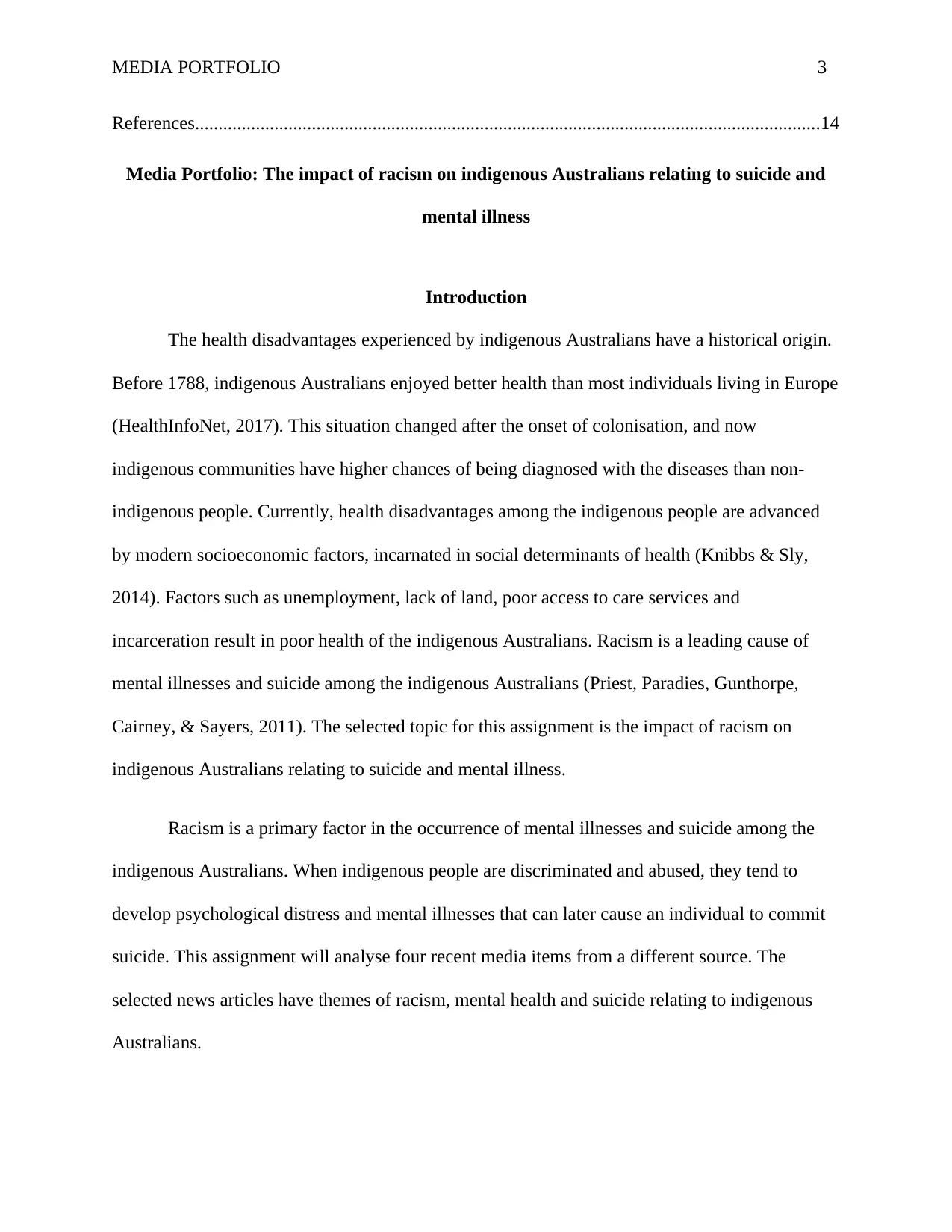
MEDIA PORTFOLIO 3
References......................................................................................................................................14
Media Portfolio: The impact of racism on indigenous Australians relating to suicide and
mental illness
Introduction
The health disadvantages experienced by indigenous Australians have a historical origin.
Before 1788, indigenous Australians enjoyed better health than most individuals living in Europe
(HealthInfoNet, 2017). This situation changed after the onset of colonisation, and now
indigenous communities have higher chances of being diagnosed with the diseases than non-
indigenous people. Currently, health disadvantages among the indigenous people are advanced
by modern socioeconomic factors, incarnated in social determinants of health (Knibbs & Sly,
2014). Factors such as unemployment, lack of land, poor access to care services and
incarceration result in poor health of the indigenous Australians. Racism is a leading cause of
mental illnesses and suicide among the indigenous Australians (Priest, Paradies, Gunthorpe,
Cairney, & Sayers, 2011). The selected topic for this assignment is the impact of racism on
indigenous Australians relating to suicide and mental illness.
Racism is a primary factor in the occurrence of mental illnesses and suicide among the
indigenous Australians. When indigenous people are discriminated and abused, they tend to
develop psychological distress and mental illnesses that can later cause an individual to commit
suicide. This assignment will analyse four recent media items from a different source. The
selected news articles have themes of racism, mental health and suicide relating to indigenous
Australians.
References......................................................................................................................................14
Media Portfolio: The impact of racism on indigenous Australians relating to suicide and
mental illness
Introduction
The health disadvantages experienced by indigenous Australians have a historical origin.
Before 1788, indigenous Australians enjoyed better health than most individuals living in Europe
(HealthInfoNet, 2017). This situation changed after the onset of colonisation, and now
indigenous communities have higher chances of being diagnosed with the diseases than non-
indigenous people. Currently, health disadvantages among the indigenous people are advanced
by modern socioeconomic factors, incarnated in social determinants of health (Knibbs & Sly,
2014). Factors such as unemployment, lack of land, poor access to care services and
incarceration result in poor health of the indigenous Australians. Racism is a leading cause of
mental illnesses and suicide among the indigenous Australians (Priest, Paradies, Gunthorpe,
Cairney, & Sayers, 2011). The selected topic for this assignment is the impact of racism on
indigenous Australians relating to suicide and mental illness.
Racism is a primary factor in the occurrence of mental illnesses and suicide among the
indigenous Australians. When indigenous people are discriminated and abused, they tend to
develop psychological distress and mental illnesses that can later cause an individual to commit
suicide. This assignment will analyse four recent media items from a different source. The
selected news articles have themes of racism, mental health and suicide relating to indigenous
Australians.
⊘ This is a preview!⊘
Do you want full access?
Subscribe today to unlock all pages.

Trusted by 1+ million students worldwide
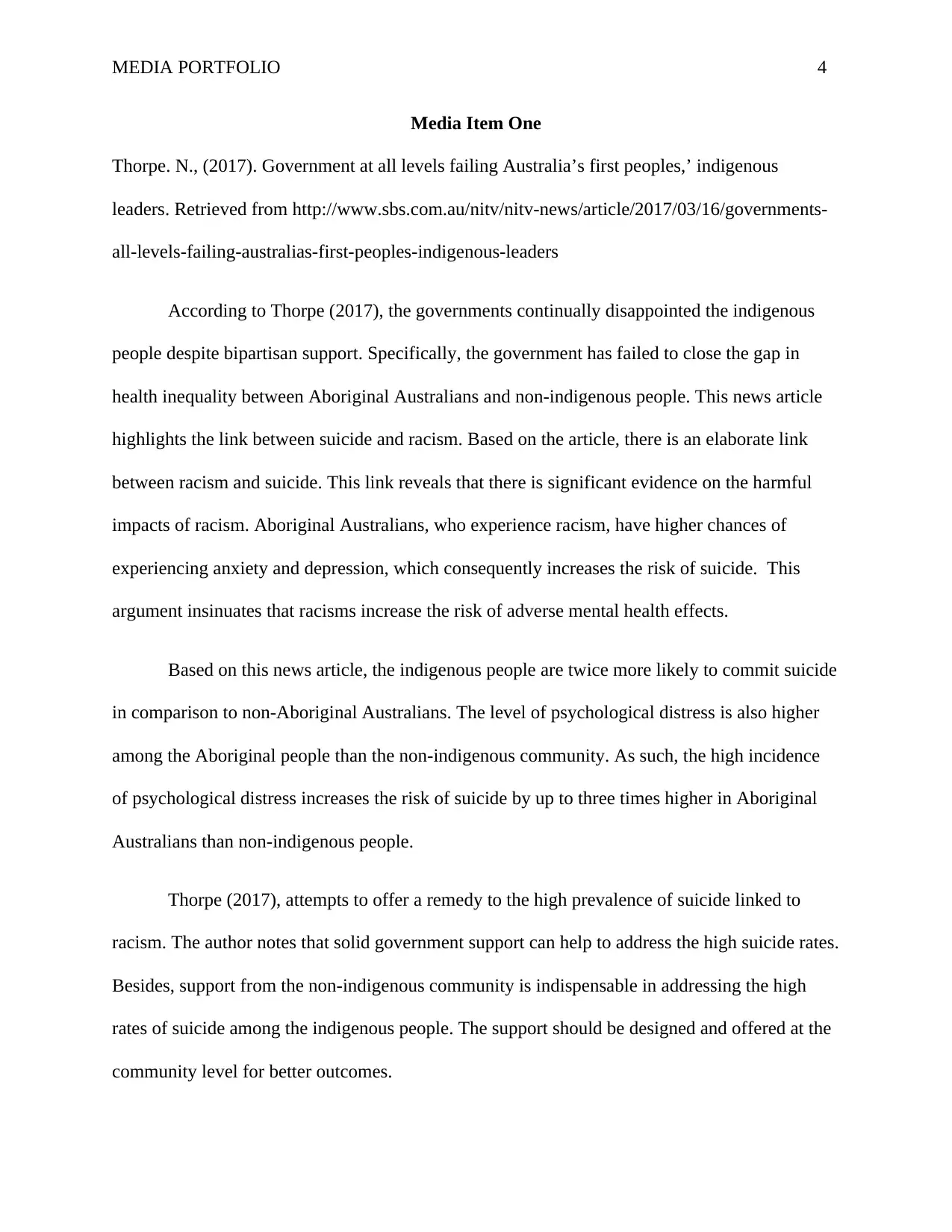
MEDIA PORTFOLIO 4
Media Item One
Thorpe. N., (2017). Government at all levels failing Australia’s first peoples,’ indigenous
leaders. Retrieved from http://www.sbs.com.au/nitv/nitv-news/article/2017/03/16/governments-
all-levels-failing-australias-first-peoples-indigenous-leaders
According to Thorpe (2017), the governments continually disappointed the indigenous
people despite bipartisan support. Specifically, the government has failed to close the gap in
health inequality between Aboriginal Australians and non-indigenous people. This news article
highlights the link between suicide and racism. Based on the article, there is an elaborate link
between racism and suicide. This link reveals that there is significant evidence on the harmful
impacts of racism. Aboriginal Australians, who experience racism, have higher chances of
experiencing anxiety and depression, which consequently increases the risk of suicide. This
argument insinuates that racisms increase the risk of adverse mental health effects.
Based on this news article, the indigenous people are twice more likely to commit suicide
in comparison to non-Aboriginal Australians. The level of psychological distress is also higher
among the Aboriginal people than the non-indigenous community. As such, the high incidence
of psychological distress increases the risk of suicide by up to three times higher in Aboriginal
Australians than non-indigenous people.
Thorpe (2017), attempts to offer a remedy to the high prevalence of suicide linked to
racism. The author notes that solid government support can help to address the high suicide rates.
Besides, support from the non-indigenous community is indispensable in addressing the high
rates of suicide among the indigenous people. The support should be designed and offered at the
community level for better outcomes.
Media Item One
Thorpe. N., (2017). Government at all levels failing Australia’s first peoples,’ indigenous
leaders. Retrieved from http://www.sbs.com.au/nitv/nitv-news/article/2017/03/16/governments-
all-levels-failing-australias-first-peoples-indigenous-leaders
According to Thorpe (2017), the governments continually disappointed the indigenous
people despite bipartisan support. Specifically, the government has failed to close the gap in
health inequality between Aboriginal Australians and non-indigenous people. This news article
highlights the link between suicide and racism. Based on the article, there is an elaborate link
between racism and suicide. This link reveals that there is significant evidence on the harmful
impacts of racism. Aboriginal Australians, who experience racism, have higher chances of
experiencing anxiety and depression, which consequently increases the risk of suicide. This
argument insinuates that racisms increase the risk of adverse mental health effects.
Based on this news article, the indigenous people are twice more likely to commit suicide
in comparison to non-Aboriginal Australians. The level of psychological distress is also higher
among the Aboriginal people than the non-indigenous community. As such, the high incidence
of psychological distress increases the risk of suicide by up to three times higher in Aboriginal
Australians than non-indigenous people.
Thorpe (2017), attempts to offer a remedy to the high prevalence of suicide linked to
racism. The author notes that solid government support can help to address the high suicide rates.
Besides, support from the non-indigenous community is indispensable in addressing the high
rates of suicide among the indigenous people. The support should be designed and offered at the
community level for better outcomes.
Paraphrase This Document
Need a fresh take? Get an instant paraphrase of this document with our AI Paraphraser
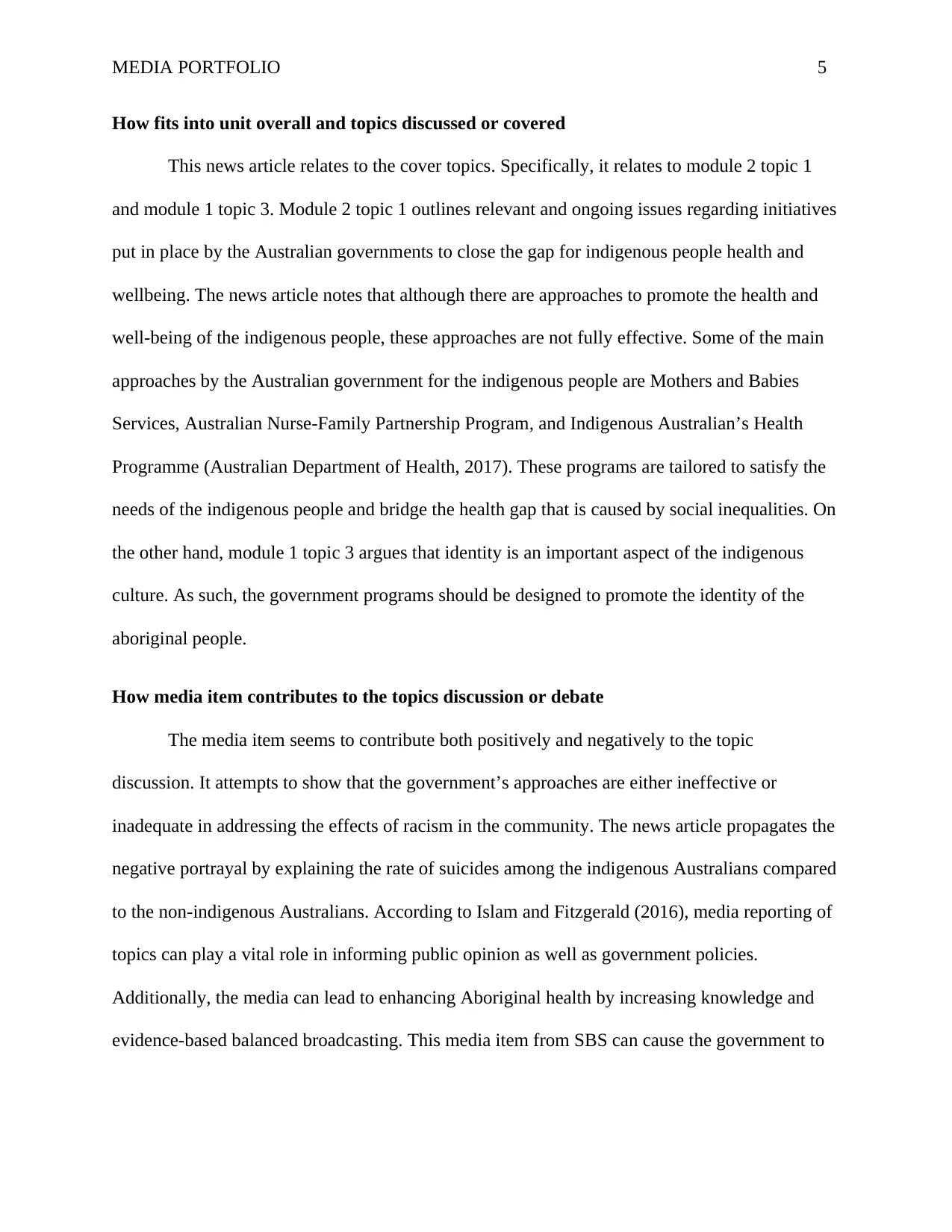
MEDIA PORTFOLIO 5
How fits into unit overall and topics discussed or covered
This news article relates to the cover topics. Specifically, it relates to module 2 topic 1
and module 1 topic 3. Module 2 topic 1 outlines relevant and ongoing issues regarding initiatives
put in place by the Australian governments to close the gap for indigenous people health and
wellbeing. The news article notes that although there are approaches to promote the health and
well-being of the indigenous people, these approaches are not fully effective. Some of the main
approaches by the Australian government for the indigenous people are Mothers and Babies
Services, Australian Nurse-Family Partnership Program, and Indigenous Australian’s Health
Programme (Australian Department of Health, 2017). These programs are tailored to satisfy the
needs of the indigenous people and bridge the health gap that is caused by social inequalities. On
the other hand, module 1 topic 3 argues that identity is an important aspect of the indigenous
culture. As such, the government programs should be designed to promote the identity of the
aboriginal people.
How media item contributes to the topics discussion or debate
The media item seems to contribute both positively and negatively to the topic
discussion. It attempts to show that the government’s approaches are either ineffective or
inadequate in addressing the effects of racism in the community. The news article propagates the
negative portrayal by explaining the rate of suicides among the indigenous Australians compared
to the non-indigenous Australians. According to Islam and Fitzgerald (2016), media reporting of
topics can play a vital role in informing public opinion as well as government policies.
Additionally, the media can lead to enhancing Aboriginal health by increasing knowledge and
evidence-based balanced broadcasting. This media item from SBS can cause the government to
How fits into unit overall and topics discussed or covered
This news article relates to the cover topics. Specifically, it relates to module 2 topic 1
and module 1 topic 3. Module 2 topic 1 outlines relevant and ongoing issues regarding initiatives
put in place by the Australian governments to close the gap for indigenous people health and
wellbeing. The news article notes that although there are approaches to promote the health and
well-being of the indigenous people, these approaches are not fully effective. Some of the main
approaches by the Australian government for the indigenous people are Mothers and Babies
Services, Australian Nurse-Family Partnership Program, and Indigenous Australian’s Health
Programme (Australian Department of Health, 2017). These programs are tailored to satisfy the
needs of the indigenous people and bridge the health gap that is caused by social inequalities. On
the other hand, module 1 topic 3 argues that identity is an important aspect of the indigenous
culture. As such, the government programs should be designed to promote the identity of the
aboriginal people.
How media item contributes to the topics discussion or debate
The media item seems to contribute both positively and negatively to the topic
discussion. It attempts to show that the government’s approaches are either ineffective or
inadequate in addressing the effects of racism in the community. The news article propagates the
negative portrayal by explaining the rate of suicides among the indigenous Australians compared
to the non-indigenous Australians. According to Islam and Fitzgerald (2016), media reporting of
topics can play a vital role in informing public opinion as well as government policies.
Additionally, the media can lead to enhancing Aboriginal health by increasing knowledge and
evidence-based balanced broadcasting. This media item from SBS can cause the government to
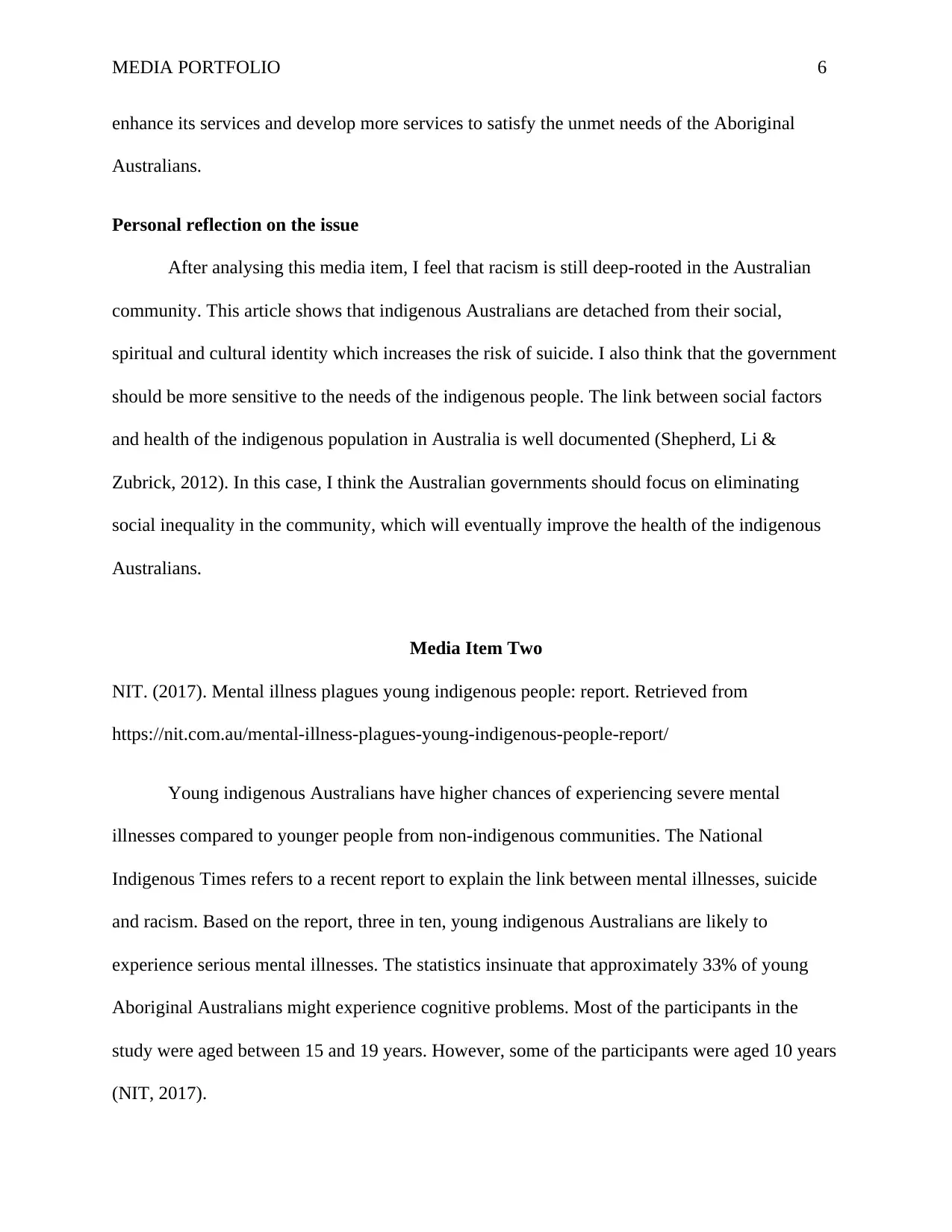
MEDIA PORTFOLIO 6
enhance its services and develop more services to satisfy the unmet needs of the Aboriginal
Australians.
Personal reflection on the issue
After analysing this media item, I feel that racism is still deep-rooted in the Australian
community. This article shows that indigenous Australians are detached from their social,
spiritual and cultural identity which increases the risk of suicide. I also think that the government
should be more sensitive to the needs of the indigenous people. The link between social factors
and health of the indigenous population in Australia is well documented (Shepherd, Li &
Zubrick, 2012). In this case, I think the Australian governments should focus on eliminating
social inequality in the community, which will eventually improve the health of the indigenous
Australians.
Media Item Two
NIT. (2017). Mental illness plagues young indigenous people: report. Retrieved from
https://nit.com.au/mental-illness-plagues-young-indigenous-people-report/
Young indigenous Australians have higher chances of experiencing severe mental
illnesses compared to younger people from non-indigenous communities. The National
Indigenous Times refers to a recent report to explain the link between mental illnesses, suicide
and racism. Based on the report, three in ten, young indigenous Australians are likely to
experience serious mental illnesses. The statistics insinuate that approximately 33% of young
Aboriginal Australians might experience cognitive problems. Most of the participants in the
study were aged between 15 and 19 years. However, some of the participants were aged 10 years
(NIT, 2017).
enhance its services and develop more services to satisfy the unmet needs of the Aboriginal
Australians.
Personal reflection on the issue
After analysing this media item, I feel that racism is still deep-rooted in the Australian
community. This article shows that indigenous Australians are detached from their social,
spiritual and cultural identity which increases the risk of suicide. I also think that the government
should be more sensitive to the needs of the indigenous people. The link between social factors
and health of the indigenous population in Australia is well documented (Shepherd, Li &
Zubrick, 2012). In this case, I think the Australian governments should focus on eliminating
social inequality in the community, which will eventually improve the health of the indigenous
Australians.
Media Item Two
NIT. (2017). Mental illness plagues young indigenous people: report. Retrieved from
https://nit.com.au/mental-illness-plagues-young-indigenous-people-report/
Young indigenous Australians have higher chances of experiencing severe mental
illnesses compared to younger people from non-indigenous communities. The National
Indigenous Times refers to a recent report to explain the link between mental illnesses, suicide
and racism. Based on the report, three in ten, young indigenous Australians are likely to
experience serious mental illnesses. The statistics insinuate that approximately 33% of young
Aboriginal Australians might experience cognitive problems. Most of the participants in the
study were aged between 15 and 19 years. However, some of the participants were aged 10 years
(NIT, 2017).
⊘ This is a preview!⊘
Do you want full access?
Subscribe today to unlock all pages.

Trusted by 1+ million students worldwide
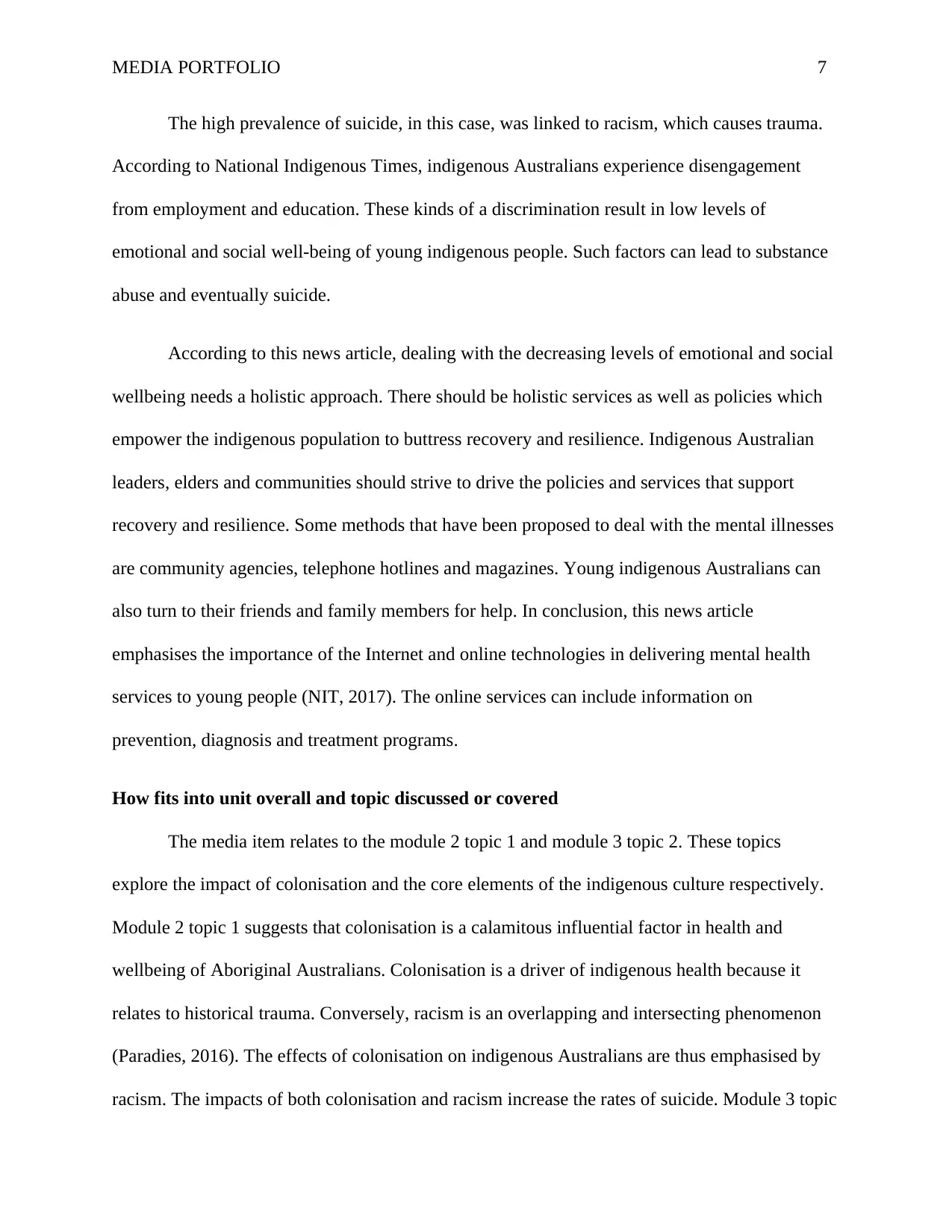
MEDIA PORTFOLIO 7
The high prevalence of suicide, in this case, was linked to racism, which causes trauma.
According to National Indigenous Times, indigenous Australians experience disengagement
from employment and education. These kinds of a discrimination result in low levels of
emotional and social well-being of young indigenous people. Such factors can lead to substance
abuse and eventually suicide.
According to this news article, dealing with the decreasing levels of emotional and social
wellbeing needs a holistic approach. There should be holistic services as well as policies which
empower the indigenous population to buttress recovery and resilience. Indigenous Australian
leaders, elders and communities should strive to drive the policies and services that support
recovery and resilience. Some methods that have been proposed to deal with the mental illnesses
are community agencies, telephone hotlines and magazines. Young indigenous Australians can
also turn to their friends and family members for help. In conclusion, this news article
emphasises the importance of the Internet and online technologies in delivering mental health
services to young people (NIT, 2017). The online services can include information on
prevention, diagnosis and treatment programs.
How fits into unit overall and topic discussed or covered
The media item relates to the module 2 topic 1 and module 3 topic 2. These topics
explore the impact of colonisation and the core elements of the indigenous culture respectively.
Module 2 topic 1 suggests that colonisation is a calamitous influential factor in health and
wellbeing of Aboriginal Australians. Colonisation is a driver of indigenous health because it
relates to historical trauma. Conversely, racism is an overlapping and intersecting phenomenon
(Paradies, 2016). The effects of colonisation on indigenous Australians are thus emphasised by
racism. The impacts of both colonisation and racism increase the rates of suicide. Module 3 topic
The high prevalence of suicide, in this case, was linked to racism, which causes trauma.
According to National Indigenous Times, indigenous Australians experience disengagement
from employment and education. These kinds of a discrimination result in low levels of
emotional and social well-being of young indigenous people. Such factors can lead to substance
abuse and eventually suicide.
According to this news article, dealing with the decreasing levels of emotional and social
wellbeing needs a holistic approach. There should be holistic services as well as policies which
empower the indigenous population to buttress recovery and resilience. Indigenous Australian
leaders, elders and communities should strive to drive the policies and services that support
recovery and resilience. Some methods that have been proposed to deal with the mental illnesses
are community agencies, telephone hotlines and magazines. Young indigenous Australians can
also turn to their friends and family members for help. In conclusion, this news article
emphasises the importance of the Internet and online technologies in delivering mental health
services to young people (NIT, 2017). The online services can include information on
prevention, diagnosis and treatment programs.
How fits into unit overall and topic discussed or covered
The media item relates to the module 2 topic 1 and module 3 topic 2. These topics
explore the impact of colonisation and the core elements of the indigenous culture respectively.
Module 2 topic 1 suggests that colonisation is a calamitous influential factor in health and
wellbeing of Aboriginal Australians. Colonisation is a driver of indigenous health because it
relates to historical trauma. Conversely, racism is an overlapping and intersecting phenomenon
(Paradies, 2016). The effects of colonisation on indigenous Australians are thus emphasised by
racism. The impacts of both colonisation and racism increase the rates of suicide. Module 3 topic
Paraphrase This Document
Need a fresh take? Get an instant paraphrase of this document with our AI Paraphraser
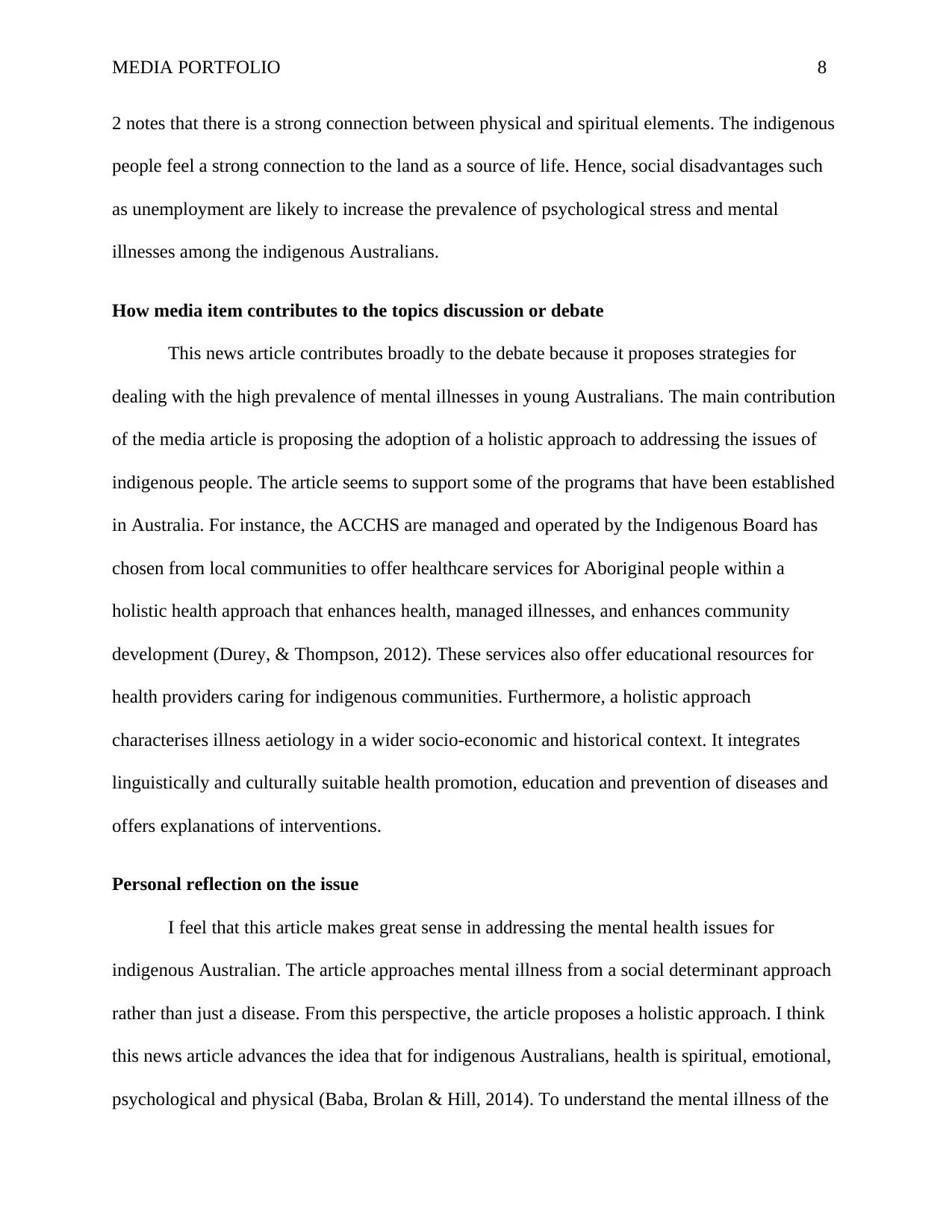
MEDIA PORTFOLIO 8
2 notes that there is a strong connection between physical and spiritual elements. The indigenous
people feel a strong connection to the land as a source of life. Hence, social disadvantages such
as unemployment are likely to increase the prevalence of psychological stress and mental
illnesses among the indigenous Australians.
How media item contributes to the topics discussion or debate
This news article contributes broadly to the debate because it proposes strategies for
dealing with the high prevalence of mental illnesses in young Australians. The main contribution
of the media article is proposing the adoption of a holistic approach to addressing the issues of
indigenous people. The article seems to support some of the programs that have been established
in Australia. For instance, the ACCHS are managed and operated by the Indigenous Board has
chosen from local communities to offer healthcare services for Aboriginal people within a
holistic health approach that enhances health, managed illnesses, and enhances community
development (Durey, & Thompson, 2012). These services also offer educational resources for
health providers caring for indigenous communities. Furthermore, a holistic approach
characterises illness aetiology in a wider socio-economic and historical context. It integrates
linguistically and culturally suitable health promotion, education and prevention of diseases and
offers explanations of interventions.
Personal reflection on the issue
I feel that this article makes great sense in addressing the mental health issues for
indigenous Australian. The article approaches mental illness from a social determinant approach
rather than just a disease. From this perspective, the article proposes a holistic approach. I think
this news article advances the idea that for indigenous Australians, health is spiritual, emotional,
psychological and physical (Baba, Brolan & Hill, 2014). To understand the mental illness of the
2 notes that there is a strong connection between physical and spiritual elements. The indigenous
people feel a strong connection to the land as a source of life. Hence, social disadvantages such
as unemployment are likely to increase the prevalence of psychological stress and mental
illnesses among the indigenous Australians.
How media item contributes to the topics discussion or debate
This news article contributes broadly to the debate because it proposes strategies for
dealing with the high prevalence of mental illnesses in young Australians. The main contribution
of the media article is proposing the adoption of a holistic approach to addressing the issues of
indigenous people. The article seems to support some of the programs that have been established
in Australia. For instance, the ACCHS are managed and operated by the Indigenous Board has
chosen from local communities to offer healthcare services for Aboriginal people within a
holistic health approach that enhances health, managed illnesses, and enhances community
development (Durey, & Thompson, 2012). These services also offer educational resources for
health providers caring for indigenous communities. Furthermore, a holistic approach
characterises illness aetiology in a wider socio-economic and historical context. It integrates
linguistically and culturally suitable health promotion, education and prevention of diseases and
offers explanations of interventions.
Personal reflection on the issue
I feel that this article makes great sense in addressing the mental health issues for
indigenous Australian. The article approaches mental illness from a social determinant approach
rather than just a disease. From this perspective, the article proposes a holistic approach. I think
this news article advances the idea that for indigenous Australians, health is spiritual, emotional,
psychological and physical (Baba, Brolan & Hill, 2014). To understand the mental illness of the
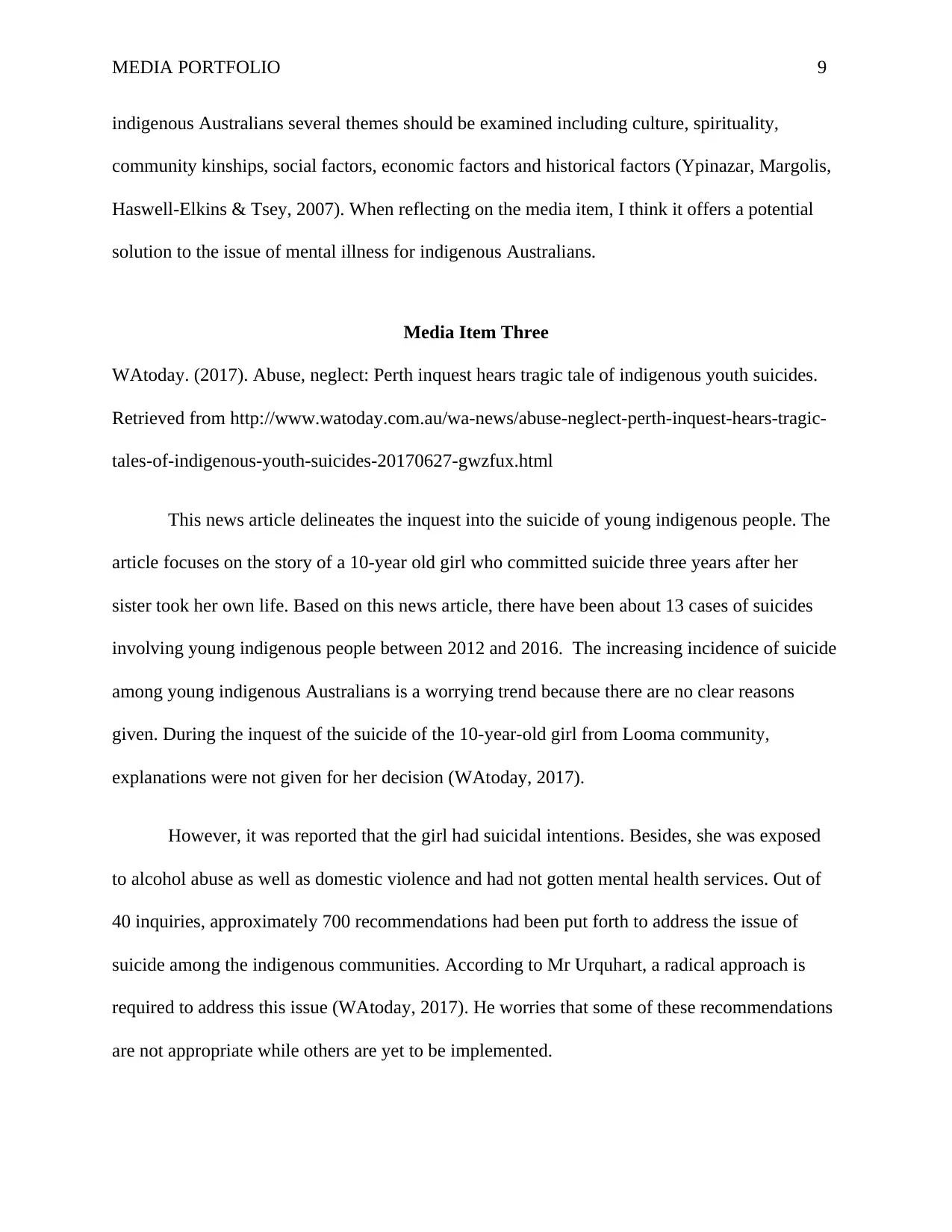
MEDIA PORTFOLIO 9
indigenous Australians several themes should be examined including culture, spirituality,
community kinships, social factors, economic factors and historical factors (Ypinazar, Margolis,
Haswell-Elkins & Tsey, 2007). When reflecting on the media item, I think it offers a potential
solution to the issue of mental illness for indigenous Australians.
Media Item Three
WAtoday. (2017). Abuse, neglect: Perth inquest hears tragic tale of indigenous youth suicides.
Retrieved from http://www.watoday.com.au/wa-news/abuse-neglect-perth-inquest-hears-tragic-
tales-of-indigenous-youth-suicides-20170627-gwzfux.html
This news article delineates the inquest into the suicide of young indigenous people. The
article focuses on the story of a 10-year old girl who committed suicide three years after her
sister took her own life. Based on this news article, there have been about 13 cases of suicides
involving young indigenous people between 2012 and 2016. The increasing incidence of suicide
among young indigenous Australians is a worrying trend because there are no clear reasons
given. During the inquest of the suicide of the 10-year-old girl from Looma community,
explanations were not given for her decision (WAtoday, 2017).
However, it was reported that the girl had suicidal intentions. Besides, she was exposed
to alcohol abuse as well as domestic violence and had not gotten mental health services. Out of
40 inquiries, approximately 700 recommendations had been put forth to address the issue of
suicide among the indigenous communities. According to Mr Urquhart, a radical approach is
required to address this issue (WAtoday, 2017). He worries that some of these recommendations
are not appropriate while others are yet to be implemented.
indigenous Australians several themes should be examined including culture, spirituality,
community kinships, social factors, economic factors and historical factors (Ypinazar, Margolis,
Haswell-Elkins & Tsey, 2007). When reflecting on the media item, I think it offers a potential
solution to the issue of mental illness for indigenous Australians.
Media Item Three
WAtoday. (2017). Abuse, neglect: Perth inquest hears tragic tale of indigenous youth suicides.
Retrieved from http://www.watoday.com.au/wa-news/abuse-neglect-perth-inquest-hears-tragic-
tales-of-indigenous-youth-suicides-20170627-gwzfux.html
This news article delineates the inquest into the suicide of young indigenous people. The
article focuses on the story of a 10-year old girl who committed suicide three years after her
sister took her own life. Based on this news article, there have been about 13 cases of suicides
involving young indigenous people between 2012 and 2016. The increasing incidence of suicide
among young indigenous Australians is a worrying trend because there are no clear reasons
given. During the inquest of the suicide of the 10-year-old girl from Looma community,
explanations were not given for her decision (WAtoday, 2017).
However, it was reported that the girl had suicidal intentions. Besides, she was exposed
to alcohol abuse as well as domestic violence and had not gotten mental health services. Out of
40 inquiries, approximately 700 recommendations had been put forth to address the issue of
suicide among the indigenous communities. According to Mr Urquhart, a radical approach is
required to address this issue (WAtoday, 2017). He worries that some of these recommendations
are not appropriate while others are yet to be implemented.
⊘ This is a preview!⊘
Do you want full access?
Subscribe today to unlock all pages.

Trusted by 1+ million students worldwide
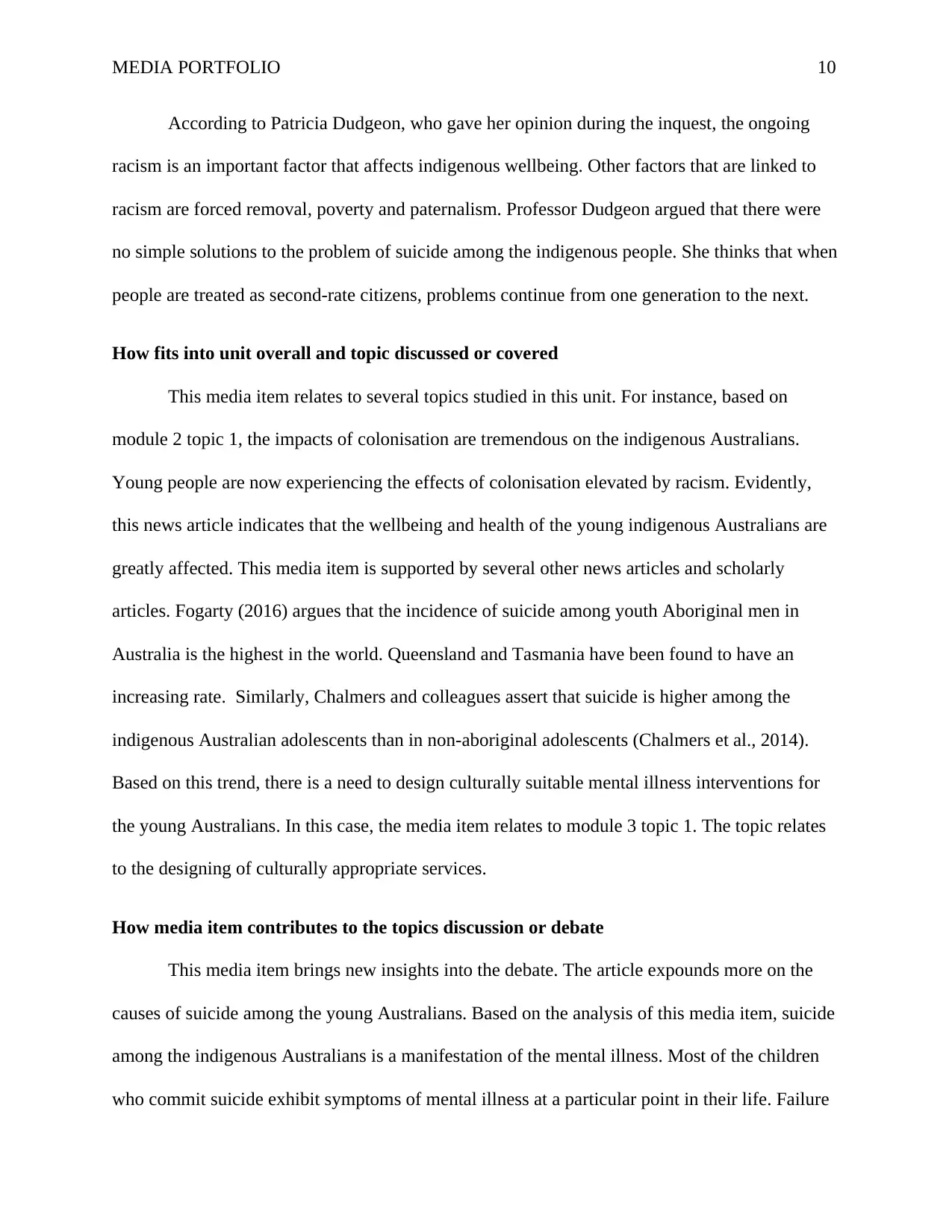
MEDIA PORTFOLIO 10
According to Patricia Dudgeon, who gave her opinion during the inquest, the ongoing
racism is an important factor that affects indigenous wellbeing. Other factors that are linked to
racism are forced removal, poverty and paternalism. Professor Dudgeon argued that there were
no simple solutions to the problem of suicide among the indigenous people. She thinks that when
people are treated as second-rate citizens, problems continue from one generation to the next.
How fits into unit overall and topic discussed or covered
This media item relates to several topics studied in this unit. For instance, based on
module 2 topic 1, the impacts of colonisation are tremendous on the indigenous Australians.
Young people are now experiencing the effects of colonisation elevated by racism. Evidently,
this news article indicates that the wellbeing and health of the young indigenous Australians are
greatly affected. This media item is supported by several other news articles and scholarly
articles. Fogarty (2016) argues that the incidence of suicide among youth Aboriginal men in
Australia is the highest in the world. Queensland and Tasmania have been found to have an
increasing rate. Similarly, Chalmers and colleagues assert that suicide is higher among the
indigenous Australian adolescents than in non-aboriginal adolescents (Chalmers et al., 2014).
Based on this trend, there is a need to design culturally suitable mental illness interventions for
the young Australians. In this case, the media item relates to module 3 topic 1. The topic relates
to the designing of culturally appropriate services.
How media item contributes to the topics discussion or debate
This media item brings new insights into the debate. The article expounds more on the
causes of suicide among the young Australians. Based on the analysis of this media item, suicide
among the indigenous Australians is a manifestation of the mental illness. Most of the children
who commit suicide exhibit symptoms of mental illness at a particular point in their life. Failure
According to Patricia Dudgeon, who gave her opinion during the inquest, the ongoing
racism is an important factor that affects indigenous wellbeing. Other factors that are linked to
racism are forced removal, poverty and paternalism. Professor Dudgeon argued that there were
no simple solutions to the problem of suicide among the indigenous people. She thinks that when
people are treated as second-rate citizens, problems continue from one generation to the next.
How fits into unit overall and topic discussed or covered
This media item relates to several topics studied in this unit. For instance, based on
module 2 topic 1, the impacts of colonisation are tremendous on the indigenous Australians.
Young people are now experiencing the effects of colonisation elevated by racism. Evidently,
this news article indicates that the wellbeing and health of the young indigenous Australians are
greatly affected. This media item is supported by several other news articles and scholarly
articles. Fogarty (2016) argues that the incidence of suicide among youth Aboriginal men in
Australia is the highest in the world. Queensland and Tasmania have been found to have an
increasing rate. Similarly, Chalmers and colleagues assert that suicide is higher among the
indigenous Australian adolescents than in non-aboriginal adolescents (Chalmers et al., 2014).
Based on this trend, there is a need to design culturally suitable mental illness interventions for
the young Australians. In this case, the media item relates to module 3 topic 1. The topic relates
to the designing of culturally appropriate services.
How media item contributes to the topics discussion or debate
This media item brings new insights into the debate. The article expounds more on the
causes of suicide among the young Australians. Based on the analysis of this media item, suicide
among the indigenous Australians is a manifestation of the mental illness. Most of the children
who commit suicide exhibit symptoms of mental illness at a particular point in their life. Failure
Paraphrase This Document
Need a fresh take? Get an instant paraphrase of this document with our AI Paraphraser
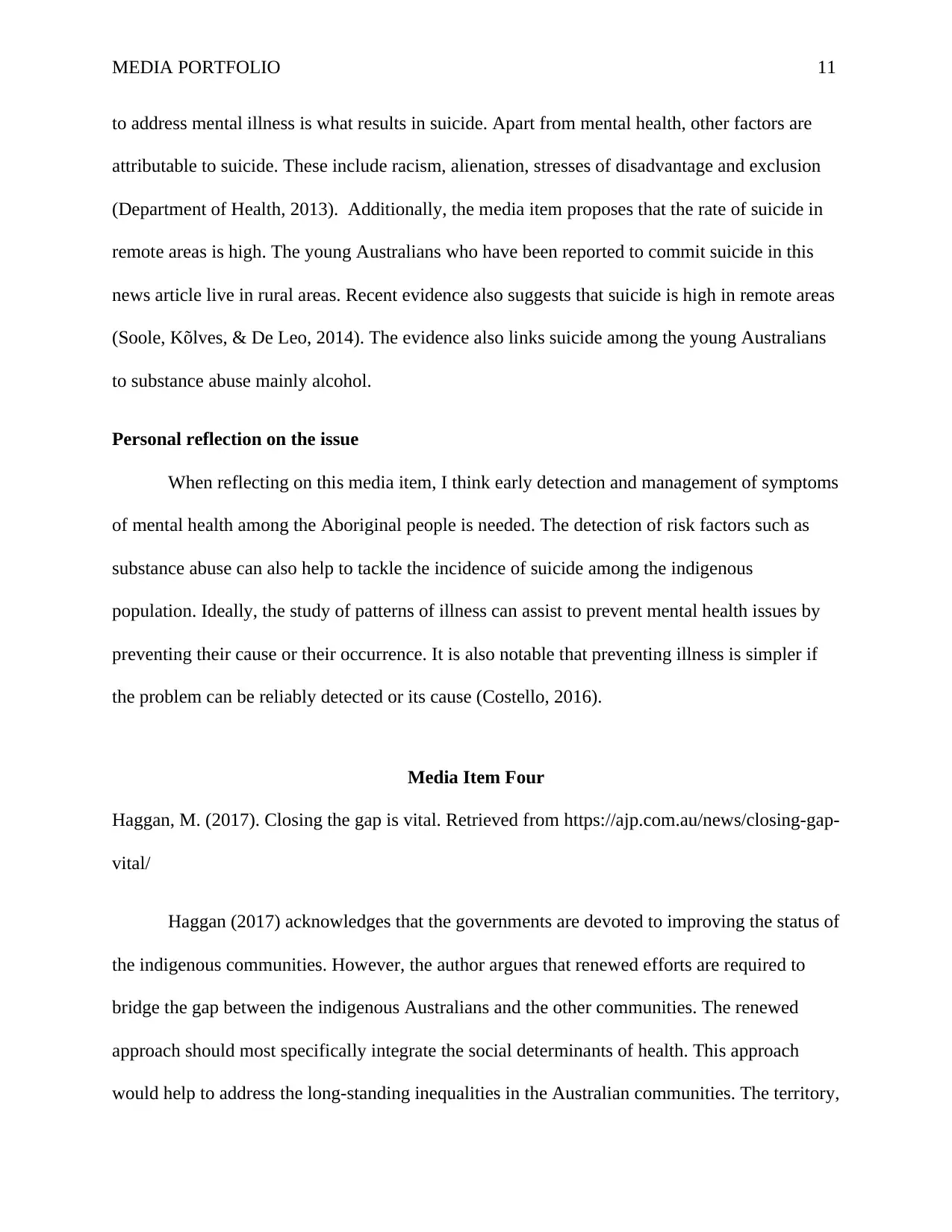
MEDIA PORTFOLIO 11
to address mental illness is what results in suicide. Apart from mental health, other factors are
attributable to suicide. These include racism, alienation, stresses of disadvantage and exclusion
(Department of Health, 2013). Additionally, the media item proposes that the rate of suicide in
remote areas is high. The young Australians who have been reported to commit suicide in this
news article live in rural areas. Recent evidence also suggests that suicide is high in remote areas
(Soole, Kõlves, & De Leo, 2014). The evidence also links suicide among the young Australians
to substance abuse mainly alcohol.
Personal reflection on the issue
When reflecting on this media item, I think early detection and management of symptoms
of mental health among the Aboriginal people is needed. The detection of risk factors such as
substance abuse can also help to tackle the incidence of suicide among the indigenous
population. Ideally, the study of patterns of illness can assist to prevent mental health issues by
preventing their cause or their occurrence. It is also notable that preventing illness is simpler if
the problem can be reliably detected or its cause (Costello, 2016).
Media Item Four
Haggan, M. (2017). Closing the gap is vital. Retrieved from https://ajp.com.au/news/closing-gap-
vital/
Haggan (2017) acknowledges that the governments are devoted to improving the status of
the indigenous communities. However, the author argues that renewed efforts are required to
bridge the gap between the indigenous Australians and the other communities. The renewed
approach should most specifically integrate the social determinants of health. This approach
would help to address the long-standing inequalities in the Australian communities. The territory,
to address mental illness is what results in suicide. Apart from mental health, other factors are
attributable to suicide. These include racism, alienation, stresses of disadvantage and exclusion
(Department of Health, 2013). Additionally, the media item proposes that the rate of suicide in
remote areas is high. The young Australians who have been reported to commit suicide in this
news article live in rural areas. Recent evidence also suggests that suicide is high in remote areas
(Soole, Kõlves, & De Leo, 2014). The evidence also links suicide among the young Australians
to substance abuse mainly alcohol.
Personal reflection on the issue
When reflecting on this media item, I think early detection and management of symptoms
of mental health among the Aboriginal people is needed. The detection of risk factors such as
substance abuse can also help to tackle the incidence of suicide among the indigenous
population. Ideally, the study of patterns of illness can assist to prevent mental health issues by
preventing their cause or their occurrence. It is also notable that preventing illness is simpler if
the problem can be reliably detected or its cause (Costello, 2016).
Media Item Four
Haggan, M. (2017). Closing the gap is vital. Retrieved from https://ajp.com.au/news/closing-gap-
vital/
Haggan (2017) acknowledges that the governments are devoted to improving the status of
the indigenous communities. However, the author argues that renewed efforts are required to
bridge the gap between the indigenous Australians and the other communities. The renewed
approach should most specifically integrate the social determinants of health. This approach
would help to address the long-standing inequalities in the Australian communities. The territory,
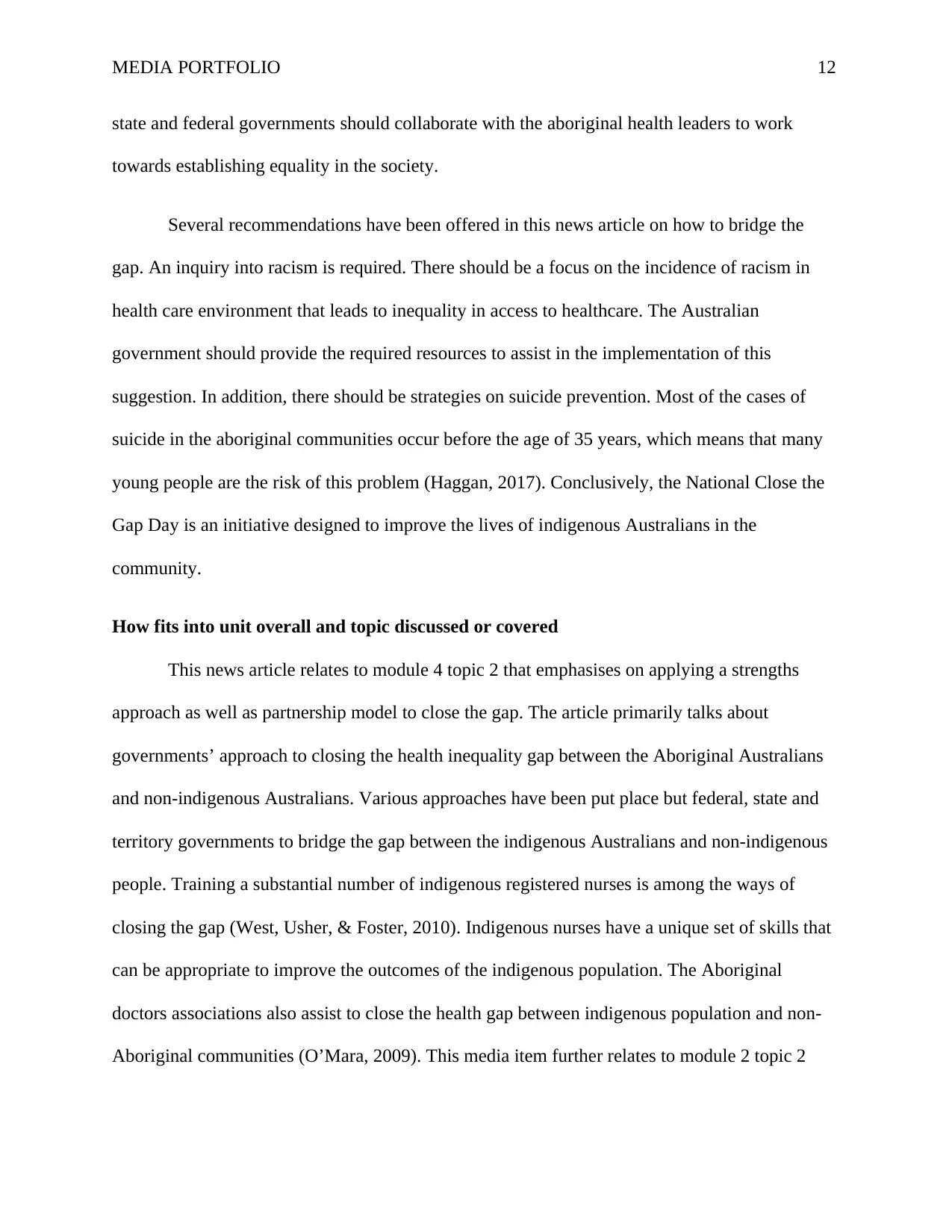
MEDIA PORTFOLIO 12
state and federal governments should collaborate with the aboriginal health leaders to work
towards establishing equality in the society.
Several recommendations have been offered in this news article on how to bridge the
gap. An inquiry into racism is required. There should be a focus on the incidence of racism in
health care environment that leads to inequality in access to healthcare. The Australian
government should provide the required resources to assist in the implementation of this
suggestion. In addition, there should be strategies on suicide prevention. Most of the cases of
suicide in the aboriginal communities occur before the age of 35 years, which means that many
young people are the risk of this problem (Haggan, 2017). Conclusively, the National Close the
Gap Day is an initiative designed to improve the lives of indigenous Australians in the
community.
How fits into unit overall and topic discussed or covered
This news article relates to module 4 topic 2 that emphasises on applying a strengths
approach as well as partnership model to close the gap. The article primarily talks about
governments’ approach to closing the health inequality gap between the Aboriginal Australians
and non-indigenous Australians. Various approaches have been put place but federal, state and
territory governments to bridge the gap between the indigenous Australians and non-indigenous
people. Training a substantial number of indigenous registered nurses is among the ways of
closing the gap (West, Usher, & Foster, 2010). Indigenous nurses have a unique set of skills that
can be appropriate to improve the outcomes of the indigenous population. The Aboriginal
doctors associations also assist to close the health gap between indigenous population and non-
Aboriginal communities (O’Mara, 2009). This media item further relates to module 2 topic 2
state and federal governments should collaborate with the aboriginal health leaders to work
towards establishing equality in the society.
Several recommendations have been offered in this news article on how to bridge the
gap. An inquiry into racism is required. There should be a focus on the incidence of racism in
health care environment that leads to inequality in access to healthcare. The Australian
government should provide the required resources to assist in the implementation of this
suggestion. In addition, there should be strategies on suicide prevention. Most of the cases of
suicide in the aboriginal communities occur before the age of 35 years, which means that many
young people are the risk of this problem (Haggan, 2017). Conclusively, the National Close the
Gap Day is an initiative designed to improve the lives of indigenous Australians in the
community.
How fits into unit overall and topic discussed or covered
This news article relates to module 4 topic 2 that emphasises on applying a strengths
approach as well as partnership model to close the gap. The article primarily talks about
governments’ approach to closing the health inequality gap between the Aboriginal Australians
and non-indigenous Australians. Various approaches have been put place but federal, state and
territory governments to bridge the gap between the indigenous Australians and non-indigenous
people. Training a substantial number of indigenous registered nurses is among the ways of
closing the gap (West, Usher, & Foster, 2010). Indigenous nurses have a unique set of skills that
can be appropriate to improve the outcomes of the indigenous population. The Aboriginal
doctors associations also assist to close the health gap between indigenous population and non-
Aboriginal communities (O’Mara, 2009). This media item further relates to module 2 topic 2
⊘ This is a preview!⊘
Do you want full access?
Subscribe today to unlock all pages.

Trusted by 1+ million students worldwide
1 out of 18
Related Documents
Your All-in-One AI-Powered Toolkit for Academic Success.
+13062052269
info@desklib.com
Available 24*7 on WhatsApp / Email
![[object Object]](/_next/static/media/star-bottom.7253800d.svg)
Unlock your academic potential
Copyright © 2020–2025 A2Z Services. All Rights Reserved. Developed and managed by ZUCOL.





